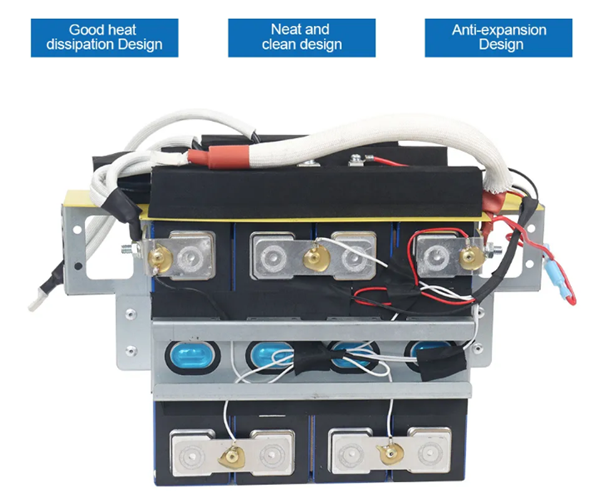TECHNICAL DISCUSSION - BATTERY CELLS
What is a prismatic Lifepo4 battery cell? A prismatic LiFePO4 battery cell is a type of rechargeable lithium iron phosphate battery that has a rectangular or square shape, as opposed to the more cylindrical shape of traditional lithium-ion cells.
Prismatic cells are typically used in applications where a higher energy density is required, and where space constraints are less of a concern. They are also more durable and have a longer lifespan than many other types of lithium-ion cells, which makes them a popular choice for electric vehicles, stationary energy storage, and other high-performance applications.
Prismatic LiFePO4 cells are often used in large battery packs, where they are connected in series and parallel configurations to achieve the desired voltage and capacity. They are also often equipped with a battery management system (BMS) to monitor their performance and ensure safe and efficient operation..
Lead acid or lifepo4?
Lead-acid batteries and LiFePO4 batteries are two types of rechargeable batteries that are commonly used in various applications. Here are some key differences between these two types of batteries:
Energy density: LiFePO4 batteries have a much higher energy density than lead-acid batteries, which means that they can store more energy per unit volume or weight. This makes them a popular choice for electric vehicles and portable electronics where energy density is a critical factor.
Cycle life: LiFePO4 batteries have a much longer cycle life than lead-acid batteries. They can typically withstand several thousand charge-discharge cycles, whereas lead-acid batteries may only last a few hundred cycles. This makes LiFePO4 batteries a more cost-effective choice over the long term.
Charging rate: LiFePO4 batteries can be charged at a much faster rate than lead-acid batteries. They can typically be charged in a fraction of the time it takes to charge a lead-acid battery.
Maintenance: LiFePO4 batteries do not require as much maintenance as lead-acid batteries. Lead-acid batteries need to be topped up with water regularly and require periodic equalization to prevent sulfation. LiFePO4 batteries are virtually maintenance-free.
Safety: LiFePO4 batteries are considered to be safer than lead-acid batteries because they are less prone to thermal runaway and do not emit toxic gases during operation.
Overall, while lead-acid batteries may be less expensive upfront, LiFePO4 batteries are a superior choice for many applications due to their higher energy density, longer cycle life, faster charging rate, lower maintenance requirements, and superior safety profile.
Lifepo4 battery grading
The grading process for LiFePO4 batteries typically involves testing and sorting the batteries based on their performance characteristics. The goal is to identify and group batteries that have similar performance, so that they can be used together in a battery pack to achieve optimal performance and longevity.
Here are some of the steps involved in the LiFePO4 battery grading process:
Capacity testing: Each battery is tested to determine its capacity, which is the amount of energy it can store. The batteries are typically discharged at a constant current to a certain voltage, and the capacity is calculated based on the amount of energy delivered.
Internal resistance testing: The internal resistance of each battery is measured, which is an indicator of the battery's ability to deliver current. Batteries with high internal resistance may have reduced performance or a shorter lifespan.
Voltage testing: The voltage of each battery is measured to ensure that it falls within a certain range. Batteries with significantly higher or lower voltages may be rejected or placed in a separate grade.
Cell balancing: The individual cells within each battery are balanced to ensure that they have similar voltages and capacities. This helps to maximize the overall performance and longevity of the battery pack.
Grading and sorting: Based on the results of the testing and balancing, the batteries are sorted into different grades or groups, based on their performance characteristics. Batteries with similar capacity, internal resistance, and voltage are grouped together to ensure optimal performance in the battery pack.
Overall, the grading process for LiFePO4 batteries is an important step in ensuring that the batteries perform optimally and have a long lifespan in a battery pack.
what is a second life battery?
A second life LiFePO4 battery is a type of rechargeable lithium iron phosphate battery that has been repurposed or reused after its original application or lifespan has ended. Instead of being recycled or disposed of, these batteries can be given a second life by using them in a new application where their remaining capacity and performance can still be useful.
Second life LiFePO4 batteries are often used in stationary energy storage systems, where they can be combined with other batteries to create a larger battery bank. Because LiFePO4 batteries have a long lifespan and can withstand many charge-discharge cycles, they can still have a significant amount of usable capacity even after they are no longer suitable for their original application.
By giving LiFePO4 batteries a second life, we can reduce the environmental impact of battery manufacturing and disposal, and make more efficient use of the resources that have already been invested in these batteries. However, it's important to note that proper testing, grading, and management of second life batteries is critical to ensure their safety and performance in their new application. There are a lot of lifepo4 batteries sold in south Africa at a slightly cheaper prices that are made with second life cells but not advertised as such. Always ask the battery manufacturer before assuming. It is an expensive mistake to make.

